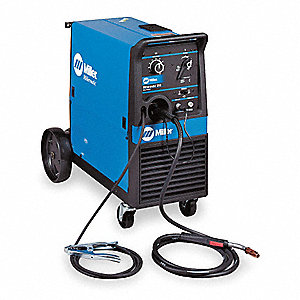Difference between revisions of "MIG Welder"
Jump to navigation
Jump to search
Jwhipple15 (talk | contribs) |
Jwhipple15 (talk | contribs) |
||
| Line 23: | Line 23: | ||
== Documentation == | == Documentation == | ||
| − | * [https://www.millerwelds.com/files/owners-manuals/o1325a_mil.pdf] | + | * [https://www.millerwelds.com/files/owners-manuals/o1325a_mil.pdf Owner's Manual] |
== Procedures: == | == Procedures: == | ||
Revision as of 14:24, 12 March 2019
The Millermatic 210 is a wire feed welder that is meant for light industrial use. It uses 72/25 CO2 and Argon gas mixture to shield the molten weld from oxygen. If the weld pool is exposed to oxygen, it can create a handful of problems such as porosity and excessive spatter in the bead. This welder is capable of welding carbon steel as well as stainless steel.
The current Ace of the MIG Welder is Wyatt Bertis (wbertis22@georgefox.edu).
Documentation
Procedures:
Prior to Welding
- Place the fume hood over the area you will be welding at
- Attach the ground clamp to the bench your workpiece will be on
- Ensure the workpiece is touching the conductive surface of the table
- Ensure the adjusting screw on the tank regulator is loose (Do not unscrew all the way)
- Open cylinder valve all the way
- Turn the adjusting screw (clockwise) to increase pressure to 15 CFH.
- Identify material type and thickness that is going to be welded
- Refer to MIG welding chart for specified adjustments, specific to your application
- Turn on the welder and adjust wire speed and voltage
- Ensure you are wearing all necessary protective gear
- Ensure the welding torch has proper amount of wire protruding from tip (about ¼ inch) If too long, trim excess with the welding pliers.
- Weld!
After Welding
- Close gas cylinder valve
- Bleed remaining gas by depressing trigger until regulator drops to 0
- Back out adjusting screw on regulator (Do Not unscrew all the way)
- Turn off the welder
- Remove ground clamp
Warnings:
- Don’t weld lead, zinc, copper, cadmium, stainless, or beryllium. Welding these materials can be harmful if not equipped with proper safety gear and training.
- Don’t weld in wet gear or standing water
- Always turn gas and the welder off when you are done in the welding shop
- Never weld without a welding helmet
- Never weld without gloves
- Don't weld with the vent hood off
- Don't weld with the gas off
- Don't exceed gas pressure past specified value
- Don’t unscrew valve adjusting screw all the way out
